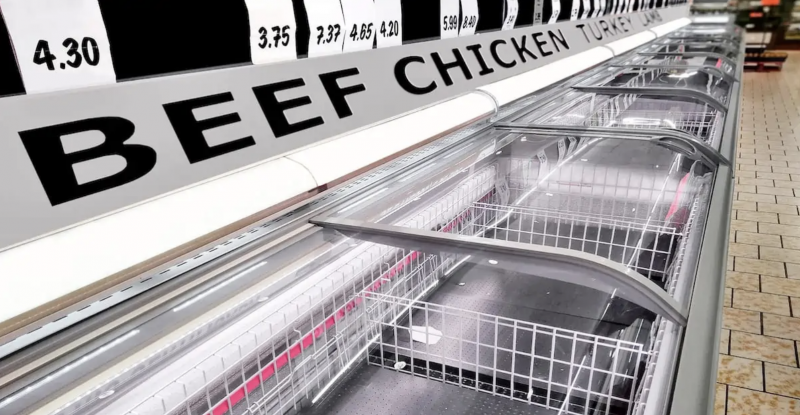Food Shortage, Insect Eating Headlines are Not Fear Porn
- April 30, 2022
- / Peter Breggin MD and Ginger Ross Breggin
- / Globalism

Food Shortage, Insect Eating Headlines are Not Fear Porn
by Peter Breggin MD and Ginger Ross Breggin
Originally posted on America Out Loud Mar 21, 2022 | Lifestyle, Media, Politics
The World Economic Forum (WEF) has big plans for the people of planet Earth for the year 2030. We will be living more closely together, we will have global universal health care run by the World Health Organization (WHO), and we “will own nothing and be happy.”1,2
WEF and other globalists have been making plans for all of us for decades. As it turns out, these are not just pie in the sky musings of rich elites — they are implementing these plans. If there is any question, look at how thoroughly planned the COVID-19 pandemic was.3,4
But there are some rumors that are just beyond credibility, aren’t there? Like the rumor that by the year 2030, we are going to be eating insects for our protein sources?
Surely that is just more fear porn.
We are learning to notice the fear porn as it shows up in our news and on our browsers. What inevitably negative prediction is being floated now to frighten us and raise collective anxiety levels? How are we being manipulated this week?
I shop and prepare food for my husband, my 95-year-old mom, and myself, so thoughts of food shortages are not an idle intellectual exercise. This could affect us personally and profoundly. It could affect every other citizen of our country and citizens around the world.
So let’s examine food. We keep hearing the rumors that food shortages are coming. Then at the grocery store, we notice empty shelves with no explanation. No longer is it just toilet paper and hand sanitizer that is unavailable. Since those shortages in 2020, we understand that supplies can run out. For a while now, packaged pizza dough was unavailable and is still scarce. Well, we can all survive without pizza dough. But this week, it was bananas that were missing.
Is this just supply lines breaking and fuel shortages? Are there a tonnage of bananas down in Central America somewhere, just waiting for a ship to get refueled before setting sail for America?5
Or are there several mass shipments of bananas on ships waiting their turn to be offloaded in Long Beach, California? You know, the port where there were increasing backlogs of shipments from around the world. Backlogs on ships idling at sea, lined up for miles to access the docks. Or stacked shipping containers backlogged on the docks, waiting to be unpacked and distributed throughout the country via truck and rail.6
Some food shortages are due to drought, in the California breadbasket, for example. There are news stories that California is suffering its third drought year in a row.7 Well, that’s global warming for you. But wait. I remember hearing about water being diverted from agricultural use in California in 2008, causing swathes of the state’s breadbasket to go fallow. The Green Lobby and environmentalists pressured courts and legislators to divert water away from the reservoir system providing water for crops and into streams and rivers and thus to the ocean. The argument was that this action was needed to save a rare salmon and the 2-inch Delta smelt. Some farmers went bankrupt then.
During the next decade, there was a 7-year drought. Finally, the rains came once again and the reservoirs filled to capacity in 2019. But this did not last long. The reservoirs designed to hold water to supply the state for 5 drought years went down to 42% and 37% capacity again in May 2021 after another purging into the ocean was ordered. It is becoming a familiar story. The state is instructing farmers to “repurpose” their farmland. Portions of one of the most important water conservation reservoir systems in the world are being dismantled. And the chair of the California State Water Resources Control Board, who directed it all since 2018, has now moved on to become an attorney for “one of the most powerful green NGOs’, with a reported $400 million in resources to wage legal battles to defend endangered species.”8
OK, so there is a cut back in food production in California. But we have 50 other states and a whole world with food production potential. Or maybe not.
There are alarming and continuing reports that the world’s fisheries are collapsing.9 There are reports that China is the biggest offender for having “destroyed 160,000 hectares of coral reef environment in the Philippines as of 2017.” China continues to illegally overfish waters around the world, poaching fish along other nations’ coastlines with inadequate actions on the parts of many countries to deter the predation.
We can live without fish. But we will always have chickens — that healthy, endlessly reproducible food source that gives us eggs as well as meat and is so easy many people grow flocks in their backyards. Or maybe not.
Remember those Biolabs we have heard about. The US has level 4 labs all over the world, and other countries have their own labs too.10,11 These labs study agricultural diseases that can affect both plants and crop animals, including chickens. As we documented, in our book, COVID-19 and the Global Predators: We are the Prey, accidents in these labs happen way too often.12
Currently, a disturbing number of reports are emerging in the US of Avian flu being found.13 Reuters reported on March 14, 2022, that a “commercial flock of 2.75 million egg-laying chickens in Wisconsin will be culled to prevent the spread of a highly lethal form of avian flu after birds on the farm tested positive for the disease.”14 Backyard flocks are being identified with the disease, and there are reports of wild waterfowl carrying the disease as more than 7 million chickens and turkeys in 14 states have been killed.15,16
Perhaps most suspiciously, while the alarm is raised in poultry community newspapers around the US, the Centers for Disease Control and Prevention is reporting otherwise. CDC says the H5N1 bird flu, while highly pathogenic, is low risk “to the general public’s health from the H5N1 bird flu.”17 The CDC’s statement skirts the issue of food shortages. When the CDC says there is no need to worry it is time to look more closely at what is actually going on.
But we will always have beef…that All-American staple. Burgers, barbeque and steaks, chili and tacos, served at diners’ tailgate parties and backyard cookouts.
Cattle rely on grass and on other “formulated feed based on corn or other grains.”18 And grass, as well as the many kinds of grain and corn, rely upon fertilizer. With the outbreak of the Ukraine/Russian war, there is a spiraling shortage of fertilizer. Russia is the largest producer of fertilizer, and China is second. Canada “is a distant third.”19
Loss of fertilizer will restrict the ability to feed our livestock as well as create shortages of grain for direct human consumption again in large part because of the Ukraine war. Ukraine and Russian together have produced 30 percent of global wheat exports, but this cannot be relied upon with the outbreak of war and sanctions in the region.20 It appears that this war plays into the hands of the global predators in ways we have not fully grasped.
That thought leads me to eating grasshoppers, mealy worms, cockroaches, and other small creepy crawlies. The World Economic Forum has been promoting the consumption of bugs and weeds for some time.21,22,23 The EU has been exploring insects as food for years. While we were all busy trying to obtain enough toilet paper during the lockdown in May of 2020, an EU non-profit organization “which represents the interest of the insect production sector” (wait—there is an insect production sector?) stated there is great interest in insects being used as a human food product but less for animal feed.24
Yellow mealworms were approved for marketing in the EU in May 2021 after the EU food safety agency gave a positive risk assessment for the insect to be eaten either as a whole dried insect or in the form of powder. There was a caveat about allergenic concerns among those with a known allergy to crustaceans and dust mites.25 The EU states, “It is up to consumers to decide whether they want to eat insects or not,” indicating the decision would be voluntary. Where have we heard “it is voluntary” before? If we are all hungry enough from food shortages, we may quickly squelch the squeamishness in order to survive, and the insect industry is getting ready for that day.
The World Economic Forum has been getting ready to substitute insects as human protein sources for some time, and the EU is signing on enthusiastically. “Coincidentally,” this Russian/Ukraine war is accelerating regional food shortages into a potential world food crisis. We need to look beyond facile explanations to discover the truths behind this war and the truths behind other events blamed on climate change and species protection.
And we need to open our eyes and face what is on the dinner menu for 2030 before our other food choices disappear.
Primary Author Ginger Ross Breggin.
References:
 Psychiatric Drugs
Psychiatric Drugs
 Psychiatric Reform Accomplishments
Psychiatric Reform Accomplishments